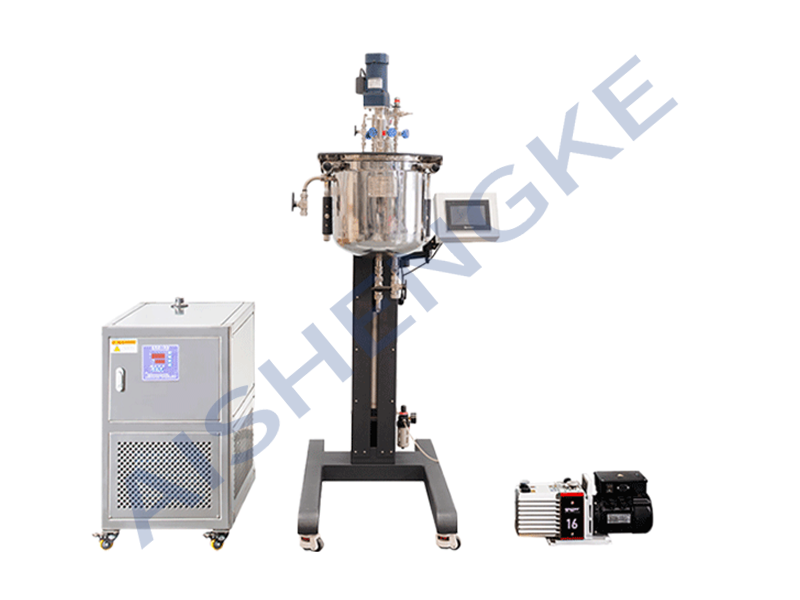Several methods of surface treatment of laboratory stainless steel reactor
Release Time:
2022-12-26
Pageviews:
Laboratory stainless steel reactors are widely used in chemical, food, coatings, hot melt adhesives, silica gel, paints, pharmaceuticals, petrochemical production reactions, pressure vessels for sulfonation, chlorination, nitration and other processes, stainless steel reactors have heating Fast, high temperature resistance, corrosion resistance, hygiene, no environmental pollution, beautiful appearance and so on. The material and material contact parts of the laboratory stainless steel reactor are made of high-quality stainless steel such as 304 or 316L, 321, which meets the GMP standard.
During the processing of stainless steel, black oxide skin is produced after coiling, edge binding, welding or artificial surface heating. This hard gray-black scale is mainly composed of two kinds of EO4, NiCr2O4 and NiF. How to surface treat the stainless steel reactor to remove this substance? Here are several surface treatment methods for stainless steel reactors:
1. Surface coloring treatment: The coloring of stainless steel autoclave not only endows stainless steel products with various colors, increases the variety of products, but also improves the wear resistance and corrosion resistance of products.
2. Mirror bright treatment method of stainless steel surface in the laboratory: according to the complexity of stainless steel autoclave products and user requirements, methods such as mechanical polishing, chemical polishing, and electrochemical polishing can be used to achieve mirror gloss.
3. Surface whitening treatment: During the processing of stainless steel, black oxide skin is produced after coiling, edge binding, welding or artificial surface heating. However, this method is costly and corrosive, so it is gradually eliminated.
4. The method of spraying glass beads to remove the black scale on the surface of the stainless steel high-pressure reactor is also very applicable today.
Latest News
2024-09-03
Abstract: Oil deacidification is an important step in food processing, which aims to remove free fatty acids in oil and improve its quality and stability. Traditional deacidification methods have some limitations, such as low efficiency, high energy consumption, and loss of nutrients. In recent years, molecular distillation technology has gradually attracted attention as a new deacidification method. This article will introduce the application of molecular distillation in oil deacidification, including the principle, operation process and advantages, and focus on the outstanding advantages of Aishengke in molecular distillation technology.
Vitamins are products that are closely related to people's lives, and have become one of the main bulk products in the international pharmaceutical and health care products market. The amount of vitamin E is the largest, followed by vitamin A, vitamin C, vitamin D and so on. With the growth of economy and the improvement of people's living standards, the demand for vitamin products will further increase, and people's requirements for their quality and grade will also further increase. Therefore, as an important separation technology in the production of many vitamins, molecular Distillation technology will also play an increasingly important role in the vitamin industry.
Glyceryl monostearate (GMS), abbreviated as monoglyceride, is produced from natural vegetable oils and fats. The active ingredient is purified by molecular distillation technology to more than 90%, also known as molecular distillation monoglyceride. It is the most widely used food Additives, safe to use in the production and processing of food, medicine, plastics, etc., account for more than half of the emulsifier consumption in the market.
The principle of molecular distillation is to make use of the different degrees of affinity between different molecules. By controlling the conditions such as temperature and pressure, the mixture begins to vaporize. Different components in the vapor form liquids in the condenser and are separated according to their boiling points. This distillation method not only has a good separation effect, but also can be repeatedly separated and purified, and is widely used in chemical, pharmaceutical and other fields.
Molecular distillation is a common chemical method used to separate and purify compounds. In the pharmaceutical industry, molecular distillation is widely used in pharmaceutical purification. This article will focus on the application of molecular distillation in pharmaceutical purification and provide some specific examples.
Laboratory vacuum distillation equipment has undergone significant advancements in recent years, driven by the need for higher efficiency, improved safety, and enhanced user experience.
Global recruitment of distributors
If you recognize the brand, technology, products and market prospects of Aishengke, we look forward to establishing a strategic partnership with you for win-win cooperation and development. Looking forward to your joining!


